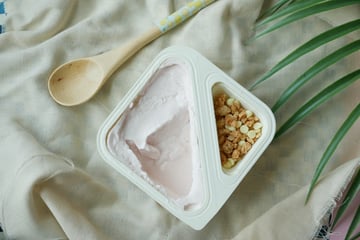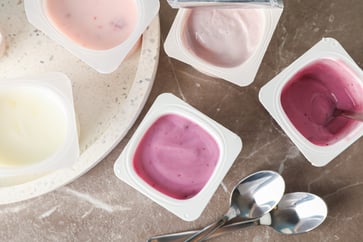 As food companies look for ways to increase sustainability of their yogurt packaging solutions, they must consider how design features and aesthetics may impact the recyclability of their product. While custom laminated designs, unique colors, or specialty additives may work well to enhance brand loyalty and make the product stand out on store shelves, these elements may result in the unintended consequence of rendering the plastic packaging non-recyclable.
As food companies look for ways to increase sustainability of their yogurt packaging solutions, they must consider how design features and aesthetics may impact the recyclability of their product. While custom laminated designs, unique colors, or specialty additives may work well to enhance brand loyalty and make the product stand out on store shelves, these elements may result in the unintended consequence of rendering the plastic packaging non-recyclable.
While consumer preference for sustainable & recyclable packaging is one of the primary forces leading companies to redesign yogurt packaging, in practice consumer’s actual behaviors towards sustainability tell a different story. An article from Food Logistics titled “The Importance of Sustainable Yogurt Packaging,” notes that when consumers were asked if sustainability is important to them, 79% of consumers said that they wanted low to zero-waste packaging foods. However, when asked to rank the importance of sustainability alongside other factors including price, flavor, packaging type, location, brand, and weight, sustainability was ranked as the second to last factor just ahead of the expiration date. In fact, the study found that people only really reflect on the environmental impact of their yogurt at the time of disposal, and instead tend to go with what they are familiar with at the point of purchase. This emphasizes that while the work that yogurt companies are doing to improve sustainability and recyclability is clearly important in more ways than one, maintaining brand identity alongside of sustainable innovation is just as critical.
It is therefore key for companies to explore ways to maintain aesthetically pleasing and innovative design and branding without detrimental impact to sustainability & recyclability. Below we discuss several factors for companies to consider when designing innovative yogurt packaging to strike the perfect balance performance, product protection, function, design, and sustainability.
Considerations for Innovative Yogurt Packaging
Performance: Ultimately, the primary purpose of the packaging is to protect the product. Yogurt can be a messy product when spills or leaks happen during transportation and distribution, or in the home. Considerations such as the impact strength of the material, which would ensure that the product stays in-tact if dropped, or top-load strength, which prevents the product from being crushed during transport, are therefore important to ensure that the integrity of the packaging and the quality of the product is preserved along the supply chain. Using a material that can meet specifications for impact strength and top-load strength, while preserving recyclability is therefore critical.
 Product Protection: Packaging plays a critical role in preserving the safety, quality and freshness of the product helping to maintain the flavor, texture, and appearance of the yogurt over a prolonged period. Since yogurt contains live cultures, it is particularly important to prevent contamination as it can cause harm to the consumer. As a result, companies will want to consider the retail and storage conditions to determine if any additional barrier materials will be required to protect the product from damage from oxygen or moisture permeation, and even light. While many yogurt applications are designed for refrigeration, and therefore do not require the use of specialty barrier materials to extend shelf-life, some shelf-stable yogurt products may require the use of EVOH to protect the product from oxygen permeation. Companies will want to consider if the inherent OTR & MVTR barrier protection of the material will be adequate and, if not, how the incorporation of a specialty barrier material will impact recyclability of the product.
Product Protection: Packaging plays a critical role in preserving the safety, quality and freshness of the product helping to maintain the flavor, texture, and appearance of the yogurt over a prolonged period. Since yogurt contains live cultures, it is particularly important to prevent contamination as it can cause harm to the consumer. As a result, companies will want to consider the retail and storage conditions to determine if any additional barrier materials will be required to protect the product from damage from oxygen or moisture permeation, and even light. While many yogurt applications are designed for refrigeration, and therefore do not require the use of specialty barrier materials to extend shelf-life, some shelf-stable yogurt products may require the use of EVOH to protect the product from oxygen permeation. Companies will want to consider if the inherent OTR & MVTR barrier protection of the material will be adequate and, if not, how the incorporation of a specialty barrier material will impact recyclability of the product.
Functional: Some innovative yogurt packaging designs include features that enhance the user’s experience with the product. This could include the inclusion of toppings such as granola or candy, mixable fruit, or a feature that allows the product to be purchased as a bundle and easily separated. Examples of this include a two-compartment flip design or yogurt multi-packs that snap apart for individual consumption. In each case, the functional and mechanical properties of the material must be considered to ensure that functional elements of the packaging are preserved without impact to recyclability. For example, incorporation of additives or mineral fillers designed to increase stiffness may have a detrimental effect on recyclability. Companies choosing to impart these functional attributes through a two-part packaging design, for example the inclusion of a smaller container for the toppings, will also want to consider minimum size requirements for recyclability.
Branding & Aesthetics: Branding and aesthetics play a critical function in shelf-appeal and consumer loyalty but can have a negative effect on recyclability. For example, opaque pigments when used with certain materials can contaminate the existing recycling stream and are therefore considered non-recyclable. However, the use, or absence, of color can influences consumer perceptions and significantly affects the identification of products. Conversely, companies looking to switch to a clear material will need to consider how the incorporation of any light degradation additives may impact recyclability. If companies feel that they cannot achieve the desired level of design and branding with the plastic container itself without impacting recyclability, they may choose to print directly on the container or use a banderol. In each case, companies will need to ensure that the inks, dyes and adhesives used are designed to easily wash off during the recycling process.
How XPP Delivers Innovative Yogurt Packaging:
XPP offers improvements to performance, function, and product protection specifications while allowing for the preservation of brand identity without sacrifice to recyclability, offering yogurt packaging companies the ideal sustainable material that delivers on all key requirements:
Performance: XPP offers enhanced stiffness and high impact strength to maintain top-load and drop-test specifications for yogurt packaging, without the use of mineral fillers or other materials that would otherwise be detrimental to recycling.
Product Protection: XPP offers inherent barrier properties without the use of specialty barrier materials or coatings, to provide a 90% improvement in OTR/MVTR barrier protection vs traditional polypropylene and 100%/150% improvement in OTR/MVTR barrier protection vs polystyrene. For applications where a medium or high level of barrier protection is required, XPP/RE-BA and XPP High Barrier with EVOH allow for extended shelf-life performance without impact to recyclability. In comparison, alternative materials including Barrier PS & Barrier PET are not considered recyclable.
Function: The customizable nature of XPP Solutions allows us to design the material to preserve functional features of the packaging design. XPP can be formulated for enhanced stiffness to provide the snap-ability required for multi-pack applications, or with increased ductility for flip-cup applications.
Branding & Aesthetics: As a 100% polypropylene solution, brand owners & food packaging companies can maintain design features such as custom colors without impact to recyclability using RIC #5. In comparison, use of custom colors in a PET structure would render the product non-recyclable.
Interested in learning more about how XPP can help you achieve your sustainability & recyclability goals without sacrifice to innovation and brand identity? Download the Ultimate Guide to Dairy Packaging to learn more about innovative yogurt packaging::




